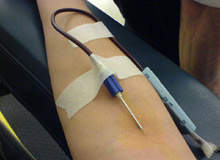
Blood transfusion errors have long been a concern of healthcare professionals with mistakes in blood tracking making news around the world, even resulting in death. While every precaution is taken to make sure the right patient gets the right blood every time the amount of manual entry needed to be carried out by hospital staff in the tracing of blood leaves it open to errors.
As radio frequency identification technology (RFID) becomes more prevalent in hospitals, tests are being carried out at London’s Mayday Healthcare NHS Trust in a pilot of vein-to-vein tracking of red blood cells to patients.
The Trust is aiming to deploy an Electronic Blood Tracking System which complies with the Electronic Clinical Transfusion Management System, (ECTMS) Specification developed by the National Patient Safety Agency, National Blood Transfusion Committee and Serious Hazards of Transfusion.
The ECTMS provides the guidance for ensuring the right patient gets the right blood and it is hoped the technology will further improve patient safety.
Split into two areas it is important to define between passive and active RFID, says project manager of the IM&T Department at Mayday Healthcare NHS Trust, Shanaz Sohal.
“People ask about RFID and they need to distinguish clearly between active and passive,” she explains. Passive tags act like a barcode which can be scanned while active tags have their own power supply and will broadcast a signal.
How well do you really know your competitors?
Access the most comprehensive Company Profiles on the market, powered by GlobalData. Save hours of research. Gain competitive edge.

Thank you!
Your download email will arrive shortly
Not ready to buy yet? Download a free sample
We are confident about the unique quality of our Company Profiles. However, we want you to make the most beneficial decision for your business, so we offer a free sample that you can download by submitting the below form
By GlobalDataThe hurdle
Active tags have come under scrutiny of late with a recent study suggesting they may interfere with medical devices. Equally, a further study from the University of Indianapolis’ Biomedical Engineering Department found that in normal clinical practice there were no issues with the use of RFID.
The studies’ author Barbara Christe says while there were a lot of similarities between the two studies the major difference was the distances between the antenna, the reader and the device.
“You could draw conclusion that based on the set two studies that if you place an antenna within a foot of the device then you might have interference however if you did that it would be very interesting as to how. It’s just not done,” she says.
Sohal says the studies have been acknowledged as part of the pilot. “We put it on the risk log of the project because it is something that could potentially jeopardise the project.” The issue is being managed by NHS Connecting for Health, which has plans to undertake testing, although currently all RFID chips being used conform to standards.
The pilot
Sohal says the pilot study is split into two main areas; a blood tracking system and an asset tracking system. “We’re going to be actively tracking red blood cells with the future potential of tracking blood products. We are tracking compatible donated blood which has been issued for a patient.”
One of the discoveries the pilot has already made is that some blood products, for example, cryoprecipitate received in the lab, do not have a readable barcode and cannot be tracked using the blood tracking system. Work is underway to remedy this so barcodes are compatible with the system.
The hospital already had Wi-Fi installed in its theatres and it has installed Pathfinder for the asset tracking, which is overseen by company Bluestar Technologies Limited.
Proof of concept testing is also being carried out in the hospital’s new Jubilee wing. Although Sohal says the hospital could use the wireless network to implement other wireless technology like mobile telephony and tracking of high value or scarce medical equipment, in terms of the blood tracking pilot, the wireless network is being used only for active tracking of the blood bags. The system tracks the journey of the red blood cells from the fridge to its destination.
Active tracking
Active RFID tags will be attached to the blood bags from the point of being received in the blood transfusion laboratory and entered on stock.
“The active tracking of the blood bags is being undertaken because Mayday feels the ECTMS is about complete traceability of the blood,” says Sohal. “Previously we didn’t know what happened to that blood and where it’s gone from the time it left the issue fridge to when it got to the patient on the ward. If you want to ensure complete traceability we felt there was a need to actually track that journey of the blood.”
She explains that the active tracking will also assist in the audit of bloods. “The implications of that are, you’re going to have less blood wastage, you won’t have an unnecessary delay of blood arriving on the ward and you’re not going to have blood bags unaccounted for. It will assist the fating process.”
The system will allow the hospital to know who has taken blood out of the fridge because they have to identify themselves when they take it out. They will then know the path they have taken to get to where the blood has to go.
Passive tracking
The passive RFID aspect of the blood tracking system sees passive RFID chips put in the patient wristband with patient identifiers entered onto the chip. Presently they are only recording basic patient demographics but in the future Sohal says the chips could store information like allergies and other details currently recorded in the Hospital’s Patient Administration System (PAS).
The patient wristband clearly identifies the patient using the demographic information on PAS. The information from PAS is obtained from the patient. In previous research done about blood transfusion it was identified that there were two weak areas, one being at the point of sample collection and again at the point of transfusion.
The Mayday system sees a unique identifier taken at the point of bleeding. This is then captured by the Pathology Laboratory Information Management System and the identifier is placed on the blood bag in the form of a 2D barcode.
“Before transfusion a comparison check will be made by reading the chip in the patient’s wristband and the 2D barcode on the compatibility label,” says Sohal. The system aims to ensure the right patient gets the right blood.
RFID’s potential
With RFID providers like Oracle and Intel estimating the market for RFID in the European healthcare sector is worth $420m, it is likely the study is being closely watched.
The adoption of RFID by an organisation as large as the NHS could be a massive leap for the electronics industry, helping to spur on research and demonstrate the business case for such technology. There have been a number of blood tracking pilots carried out throughout Europe in the past few years.
The Amsterdam study estimated in blood tracking alone the technology could save an average-sized hospital $550,000 annually through more efficient use of bloodstocks. However, the study also found some problems with active RFID interference but concluded that under real-use conditions, with careful placement of antennas and the correct power setting there was no patient risk.
Another pilot at San Raffaele in Milan tracked for autologous transfusions, or blood taken from the patient which is then returned during transfusion at a later stage. Staff members said it greatly reduced their fears of giving the wrong blood. It concluded RFID provided a robust solution for erroneous autologous blood transfusions and predicted RFID would be investigated further by hospitals and governments for blood tracking.
The Mayday test
Sohal says the pilot at Mayday is currently in phase two with the basic blood tracking system installed, but further development is required to incorporate the unique RFID identifier.
The latest lesson learnt is in trying to develop child wrist bands which will take the RFID tags. “The child wristband is much smaller and made of softer material. We are able to write to and read the chip,” says Sohal.
“We are currently experiencing problems with reading the linear and 2D barcode on the wristband. It is sufficient to say work is underway to produce a paediatric wristband.”
The pilot still has some way to go before any preliminary results are available but it is expected results will be available by August 2009. It is hoped the hospital will see a reduction in the number of samples rejected, a reduction in patient safety incidents, improved traceability of blood and blood products and better management of blood and blood products.







